Art Review: Hearts, Brains, and Donuts at the Soap Factory
Andrew Knighton ventures into the Soap Factory's redolent expanses and finds the mixed blessings of Romance.



“Your Heart Is No Match For My Love,” at No Name Exhibitions @ The Soap Factory, May 8 through June 20. Call 612.623.9176.
Nearly thirty artists contributing to a “visual conversation” about falling in love? One might well expect things to ramble a bit. But this is one of the endearing traits of “Your Heart Is No Match For My Love,” curated by Robert Blackson and Bree Edwards, and currently on display at the Soap Factory. Spatially, the show is sprawling; its dialogue is something of a cacophony. Ultimately, however, the diffuseness of the show is its primary strength, for it prevents a dangerously cutesy concept from dominating the assembled works and forcing them to be other than what they are.
The conversation at the heart of “Your Heart” instead emerges from the interplay of the works themselves, from the sparks that are released when the works encounter each other, become intimate, and yet resist assimilation into a unity. What could be more appropriate for a show about falling in love than to capture something of this energy?
Some of the show’s individual pieces are capable of sustaining interest on their own. Alexa Horochowski’s wall-size drawing of two beatific lovers, consummating their intellectual love against a pink floral background, is perfectly attuned to its space and seems to organize the room around itself. The blissful unity of its subjects — whose brains are literally being knotted together by helpful birds — is tempered by anxiety about being utterly exposed.
A similar ambivalence emerges in Brett Smith’s impressive “Ziggurat/Bunker”: The work is a massive pile of derelict mattresses, stacked and thatched together to form a cave-like hideaway beneath. Upon removing your shoes and making the wobbly climb aboard, you experience the enjoyable disequilibrium that so attracts children to those moonwalk rides at the county fair. The fun gets more complicated, however, once you enter the “bunker,” itself a throwback to childhood fort-building. Smith’s sanctum — stocked with canned goods, anarcho-apocalyptic literature, and hissy mix tapes — is all about survival, though its mixture of hermetic comfort with paranoid claustrophobia might very well induce the living to envy the dead.
These works channel the protective impulse to defend the integrity of one’s self from the seductions of pleasure, and in this respect they partake of the general ambience of the show. Literally setting the show’s tone is Karen Finley’s “Karen Calls 1-5,” in which a rotary telephone atop a small table in the exhibition space rings periodically. Those willing to be interrupted by its rings become the target of pleading voice-mails oscillating between humor and hostility — the misguided appeals of an obsessive lover. When unanswered, the phone’s plaintive ringing echoes through the exhibition space, audibly haunting it with the frustrated desire to make contact.
This desperation serves as the perfect soundtrack for Atsushi Tameda’s provocative “Jelly Doughnut,” which is exactly what its title says it is: a husk of pastry abjectly abandoned in the middle of the Soap Factory’s scarred and tracked floor, its blood red filling carved out of it. Violently penetrated and now bereft, dwarfed in the open expanses around it, it is above all vulnerable: one dim spotlight is all that inoculates it against various sad fates: being overlooked, being trod upon, being kicked about some more.
Scattered throughout the exhibition are countless little discoveries — pieces nestled in dark corners, camouflaged against support beams, tucked away here and there. Some seem like distracted bric-a-brac (among them, lockets decorated by Rama Hoffpauir that hang tangled around the space, or the mix tape installation by Heather Colvin) but even these are diverting when considered as aspects of the larger discussion that this show aims to mount. “Your Heart Is No Match For My Love” ultimately makes the best of its unevenness, its unresolved ambivalences, its excess. Sifting through such a surplus of unbridled emotions you might just find something that moves you. And isn’t that what falling in love is all about?